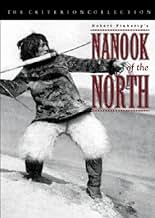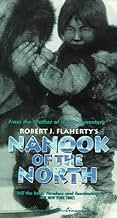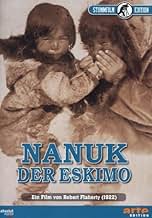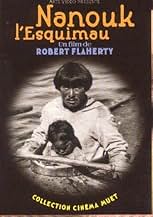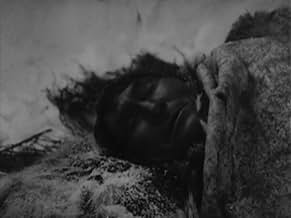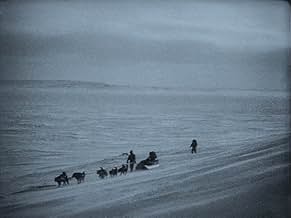CALIFICACIÓN DE IMDb
7.6/10
14 k
TU CALIFICACIÓN
En este predecesor mudo del documental moderno, el cineasta Robert J. Flaherty pasa un año siguiendo la vida de Nanook y su familia, inuits que viven en el Círculo Polar Ártico.En este predecesor mudo del documental moderno, el cineasta Robert J. Flaherty pasa un año siguiendo la vida de Nanook y su familia, inuits que viven en el Círculo Polar Ártico.En este predecesor mudo del documental moderno, el cineasta Robert J. Flaherty pasa un año siguiendo la vida de Nanook y su familia, inuits que viven en el Círculo Polar Ártico.
- Dirección
- Guionistas
- Elenco
- Premios
- 2 premios ganados en total
- Dirección
- Guionistas
- Todo el elenco y el equipo
- Producción, taquilla y más en IMDbPro
Opiniones destacadas
Thoroughly Modern Flaherty
by: Christopher M. McHugh
Robert Flaherty's second film on Eskimos, "Nanook of the North," is one of the world's first examples of a cinema verite' / aesthetic expressionism documentary. His first film outing into the Eastern Hudson Bay is now lost (allmovie.com), "Nanook of the North" was his second attempt. To deal with the extreme cold Flaherty utilized two recently developed Akeley gyroscope cameras that required little lubrication so that he could tilt and pan (cinemaweb.com). Flaherty clearly had a special place in his heart for the Itivimuit people. At times his documentary resembles a home movie, concentrating on Nanook's family's personality, rather than simply the actions they take part in. He does this primarily through the use of close-ups and filming private moments; such as the family waking up. The audience finds themselves smiling back at young Allegoo as he drinks castor oil. In regards to the soundtrack for "Nanook," the VHS copy I viewed didn't seem to match up with the visuals. When Nanook and his family are going to bed, the music is so intense it seams like the family should be fighting a bear, rather than nodding off for the night. Perhaps this problem has been remedied in the Criterion Collection's edition, which was released in 1999 on DVD (FYI available at half.com). The title cards in "Nanook" display, once again Flaherty's fondness for his subject material. Not only, Nanook's family, but Flaherty also seems to display a fondness for the Hudson Bay landscape. Flaherty does this through utilizing flowery language. For example, when we see a shot of the horizon, Flaherty's card reads: "the sun mocks them during the long winter (paraphrasing)." The lighting is excellent in "Nanook," due mostly in part to the fact that Flaherty staged sequences that couldn't be lit properly, such as building a bigger (mock) igloo to accommodate his cameras and lights. It is unclear whether these shots were filmed closer to civilization, due to Flaherty's use of the Haulberg Electric Light Plant (Flaherty 1922)and its need for fuel. Flaherty attempts to make Nanook's family a symbol for the typical, 1920's U.S. family, as (a typical U.S. family) might have lived if they were in Nanook's family's snowshoes. Flaherty even goes so far as to exclude Nanook's second wife, Cunayou (CultureDose.com) [YAY! EXTRA CREDIT!] with the exception of one particularly noticeable shot where the family is getting out of bed. Flaherty treated Nanook's family as though it might have been his own. He even went so far as to show the family dailies so that they could give him input. Flaherty pointed out in his paper, "How I filmed Nanook of the North," that he shared much with the Itivimuit, including his gramophone, tea, tobacco and sea biscuits. The Itivimuit responded back by helping out Flaherty as much as possible, leaving extra food for him and by making sure he was safe (Flaherty 1922).
As far a cinematography goes "Nanook" holds up quite well. As stated earlier, Flaherty was able to pull off pans and tilts, even in such a cold environment. The shots are framed quite well, since most of the time Flaherty didn't need to rip his equipment out in a moments notice. Nanook himself, for the most part, seemed to indicate what was going to be happening every step of the way (before it actually happened).
The pacing of "Nanook" seems to flow like rolling hills. After much action takes place Flaherty gently takes us down and puts us to bed with the family. While such action as the seal hunt is built up with quite a bit of anticipation. And when Nanook and his comrades struggle with the seal (for 20 minutes in reality), the audience is left biting their nails.
Upon viewing "Nanook" for a second time I realized how little has changed in U.S. society, as to their perceptions of those who live in a non-material world (and continue to hunt for food themselves). A 20-hundreds audience's initial reaction is probably very similar to that of a 19-twenties audience. This initial reaction subsides once Flaherty draws us into Nanook's family and they become human to us. I imagine some might criticize Flaherty for his shots of Nanook and his family members posing and smiling straight on at the camera, but these moments are most precious in "Nanook of the North." From what I gather from various sources and his paper, Mr. Flaherty was out in this frozen wilderness with no other English-speaking individuals. He obviously had a command of the language or a translator, but even more than that he obviously treated his subjects with dignity (on and off camera). His style here is closer to participant observation, rather than an ethnography. A good lesson can be learned from Flaherty, in that, great friendship and even some fun can be had when the filmmaker surrounds himself with his subject, although she or he may loose their objectivity. However, to be closer to a people is to understand them better. No one can doubt that Flaherty's take on the travel film is ingenious and that he revolutionized the film industry. To this day, "Nanook of the North" succeeds in being a modern film, easily accessible to anyone. It conveys the lifestyle and ideas of a different culture clearly and with a very human touch. And that is all that anyone could want from a documentary.
by: Christopher M. McHugh
Robert Flaherty's second film on Eskimos, "Nanook of the North," is one of the world's first examples of a cinema verite' / aesthetic expressionism documentary. His first film outing into the Eastern Hudson Bay is now lost (allmovie.com), "Nanook of the North" was his second attempt. To deal with the extreme cold Flaherty utilized two recently developed Akeley gyroscope cameras that required little lubrication so that he could tilt and pan (cinemaweb.com). Flaherty clearly had a special place in his heart for the Itivimuit people. At times his documentary resembles a home movie, concentrating on Nanook's family's personality, rather than simply the actions they take part in. He does this primarily through the use of close-ups and filming private moments; such as the family waking up. The audience finds themselves smiling back at young Allegoo as he drinks castor oil. In regards to the soundtrack for "Nanook," the VHS copy I viewed didn't seem to match up with the visuals. When Nanook and his family are going to bed, the music is so intense it seams like the family should be fighting a bear, rather than nodding off for the night. Perhaps this problem has been remedied in the Criterion Collection's edition, which was released in 1999 on DVD (FYI available at half.com). The title cards in "Nanook" display, once again Flaherty's fondness for his subject material. Not only, Nanook's family, but Flaherty also seems to display a fondness for the Hudson Bay landscape. Flaherty does this through utilizing flowery language. For example, when we see a shot of the horizon, Flaherty's card reads: "the sun mocks them during the long winter (paraphrasing)." The lighting is excellent in "Nanook," due mostly in part to the fact that Flaherty staged sequences that couldn't be lit properly, such as building a bigger (mock) igloo to accommodate his cameras and lights. It is unclear whether these shots were filmed closer to civilization, due to Flaherty's use of the Haulberg Electric Light Plant (Flaherty 1922)and its need for fuel. Flaherty attempts to make Nanook's family a symbol for the typical, 1920's U.S. family, as (a typical U.S. family) might have lived if they were in Nanook's family's snowshoes. Flaherty even goes so far as to exclude Nanook's second wife, Cunayou (CultureDose.com) [YAY! EXTRA CREDIT!] with the exception of one particularly noticeable shot where the family is getting out of bed. Flaherty treated Nanook's family as though it might have been his own. He even went so far as to show the family dailies so that they could give him input. Flaherty pointed out in his paper, "How I filmed Nanook of the North," that he shared much with the Itivimuit, including his gramophone, tea, tobacco and sea biscuits. The Itivimuit responded back by helping out Flaherty as much as possible, leaving extra food for him and by making sure he was safe (Flaherty 1922).
As far a cinematography goes "Nanook" holds up quite well. As stated earlier, Flaherty was able to pull off pans and tilts, even in such a cold environment. The shots are framed quite well, since most of the time Flaherty didn't need to rip his equipment out in a moments notice. Nanook himself, for the most part, seemed to indicate what was going to be happening every step of the way (before it actually happened).
The pacing of "Nanook" seems to flow like rolling hills. After much action takes place Flaherty gently takes us down and puts us to bed with the family. While such action as the seal hunt is built up with quite a bit of anticipation. And when Nanook and his comrades struggle with the seal (for 20 minutes in reality), the audience is left biting their nails.
Upon viewing "Nanook" for a second time I realized how little has changed in U.S. society, as to their perceptions of those who live in a non-material world (and continue to hunt for food themselves). A 20-hundreds audience's initial reaction is probably very similar to that of a 19-twenties audience. This initial reaction subsides once Flaherty draws us into Nanook's family and they become human to us. I imagine some might criticize Flaherty for his shots of Nanook and his family members posing and smiling straight on at the camera, but these moments are most precious in "Nanook of the North." From what I gather from various sources and his paper, Mr. Flaherty was out in this frozen wilderness with no other English-speaking individuals. He obviously had a command of the language or a translator, but even more than that he obviously treated his subjects with dignity (on and off camera). His style here is closer to participant observation, rather than an ethnography. A good lesson can be learned from Flaherty, in that, great friendship and even some fun can be had when the filmmaker surrounds himself with his subject, although she or he may loose their objectivity. However, to be closer to a people is to understand them better. No one can doubt that Flaherty's take on the travel film is ingenious and that he revolutionized the film industry. To this day, "Nanook of the North" succeeds in being a modern film, easily accessible to anyone. It conveys the lifestyle and ideas of a different culture clearly and with a very human touch. And that is all that anyone could want from a documentary.
When looking back to the first documentary feature ever made, Nanook of the North comes up quick. Created by Robert Flaherty between 1916 and 1921 (mainly due to technical issues), the film was praised for being the first non-fictional feature ever made, in addition to capturing the unique lives of native eskimos that audiences at the time would not have expected. Part of that has to do with how much Flaherty worked so painfully hard to pull the whole thing together for so many years, all with the cooperation and patience of his subject, Allakariallak (a.k.a. Nanook). However, that in turn creates a massive conflict with this feature, being that it might not be as factually accurate as you think.
You see, even though the film documents the everyday actions of the Iniut people far up North, Flaherty actually took some creative liberties when crafting the film. In addition to the titular character not actually carrying the name Nanook in real life, his wives were actually played by Flaherty's real life wives, and even the weapons used in the film were not what the natives of the land really used. Allakariallak was actually quite accustomed to hunting with guns rather than spears. Also, the famous comical gramophone scene was all scripted, down to Allakariallak actually knowing what that type of machine was in real life. It really paints an inaccurate and frankly dishonest way of living through people who might not have even been known to international audiences any way.
However, despite the untrue facts shown throughout, the film still works well as a tale of bravery and innovation of the Inuit people up north. Many scenes are quite fascinating to view, including some of the hunts and even how the family operates. Regardless if several sequences were staged or not, much of what happens throughout the film inflicts a unique perspective of foreigners who may live differently from others. The very fact that Allakariallak spent his life around this region displays an earnest respect for both his people and the art of filmmaking in capturing such raw moments in a land one would never consider offering much. In a way, Flaherty wanted to document whilst simultaneously experimenting with the resources around far Northern Canada without degrading the virtues of eskimo livelihood.
So even if it may not be sophisticated in every single aspect, Nanook of the North still does a pretty good job in representing what residing up in a distinct region could be like. Sure, the film's flaws may anger those looking for pure facts, but in doing so, you'd fail to realize how much of a love letter the film is to a unique culture you may not have known about to begin with. Yes, it may not be completely right, but it at least presents itself through innovative craftsmanship unlike anything seen before its time. Besides, Flaherty has stated that much of what ended up in the film was conjured up through years of experimenting and well earned research of where he was shooting. I'm sure what he did is not too far off from what many filmmakers have done since then.
You see, even though the film documents the everyday actions of the Iniut people far up North, Flaherty actually took some creative liberties when crafting the film. In addition to the titular character not actually carrying the name Nanook in real life, his wives were actually played by Flaherty's real life wives, and even the weapons used in the film were not what the natives of the land really used. Allakariallak was actually quite accustomed to hunting with guns rather than spears. Also, the famous comical gramophone scene was all scripted, down to Allakariallak actually knowing what that type of machine was in real life. It really paints an inaccurate and frankly dishonest way of living through people who might not have even been known to international audiences any way.
However, despite the untrue facts shown throughout, the film still works well as a tale of bravery and innovation of the Inuit people up north. Many scenes are quite fascinating to view, including some of the hunts and even how the family operates. Regardless if several sequences were staged or not, much of what happens throughout the film inflicts a unique perspective of foreigners who may live differently from others. The very fact that Allakariallak spent his life around this region displays an earnest respect for both his people and the art of filmmaking in capturing such raw moments in a land one would never consider offering much. In a way, Flaherty wanted to document whilst simultaneously experimenting with the resources around far Northern Canada without degrading the virtues of eskimo livelihood.
So even if it may not be sophisticated in every single aspect, Nanook of the North still does a pretty good job in representing what residing up in a distinct region could be like. Sure, the film's flaws may anger those looking for pure facts, but in doing so, you'd fail to realize how much of a love letter the film is to a unique culture you may not have known about to begin with. Yes, it may not be completely right, but it at least presents itself through innovative craftsmanship unlike anything seen before its time. Besides, Flaherty has stated that much of what ended up in the film was conjured up through years of experimenting and well earned research of where he was shooting. I'm sure what he did is not too far off from what many filmmakers have done since then.
Nanook of the North was a delight to watch from start to finish. What is captured on film is a priceless glimpse into an Eskimo family's life from the early days of film-making. Some people consider the film to be pejorative; particularly in the portrayal of Nanook as simple-minded enough to think little people live inside a phonograph speaker; or in the next frame where he is portrayed confusing a phonograph record with something to eat. I was not offended by this; conversely, considering when the film was made these scenes were endearing to me. Ultimately, what I like best about this film are the close-ups of Nanook and his family, particularly his children. The emotions expressed on their faces when they are happy and playful or sad and afraid reveal the universal link we all share as humans. It is a link that transcends the vast spaces of both cultural distance and time. The film is a masterpiece!
Years ago, in high school, I had to sit through a creaky, dim and dirty, silent black and white documentary about some Eskimo. I remember nothing of the film except that I didn't like it. Today, I had the opportunity to see a recently restored and nicely scored re-release of that film: Nanook of the North. After all the National Geographic, Nova, PBS and Discovery Channel documentaries I have seen over the years chronicling the lives of aboriginal bands of people, (aboriginal people often wearing Coca-Cola T-shirts and baseball caps), this classic 1922 epic is the best I've ever seen showing a happy people working desperately to survive in an incomprehensibly harsh environment. It is quite a compliment to the film and its subject that it retains so much power almost 80 years after it was created. The film simply documents a small group of Inuit and their children in northeast Canada as they struggle to live from day to day. That these people survive at all, let alone remain a seemingly happy, life-loving team in such a place is mind-boggling. So many of the brutally realistic scenes in this wonderful film remind me of how sterilized many contemporary documentaries have become. We see the necessary brutality of finding, stalking and killing your food. Then slicing up your kill right there on the ice and eating it where it died. We witness Nanook harpooning and then `reeling in' a walrus, catching fish with no hook and no real bait and somehow knowing where to dig a tiny hole in the ice. Then, through that tiny hole, he spears and battles to bring in a seal. And he succeeds. But more than the environment and more than the struggle, what keeps us watching this film is character. Nanook is the chief of the small tribe and the father in the main family that is followed. He is smart, curious, inventive, determined and, at the core, a happy, gregarious character that we learn to laugh with, root for and celebrate with as he keeps his family fed. His children are an absolute delight, playful and endearing, seemingly oblivious to the awful world in which they live. The film seems to have no artifice at all and everything seems to be a regular part of their life with little attention paid to the camera. If you are a lover of the documentary form, you cannot miss this re-release. It appears to have been struck from a near pristine negative and restored to its original length of somewhere over 65 minutes. The pleasant score is not too obtrusive and sounds as though it may be a reconstruction of the score composed for the theatrical re-release of the film in 1939, but the credits aren't completely clear on that. See this film.
Explorer Robert J. Flaherty spent the majority of 1914 and 1915 along the Hudson Bay, doing research and exploring for a Canadian railway company. Being a keen photographer and potential film-maker, he took a camera along with him. He shot 30,000 feet of film, of the native Eskimo tribes and their alien, hunter-gatherer lifestyle. The test footage was met with universal excitement, only Flaherty dropped a cigarette on the highly-flammable nitrate film-stock whilst editing, and lost it all. He would return, only this time with the sole intent on making a narrative- driven documentary, about one specific family of Eskimos, and their highly-charismatic leader Nanook, a legendary hunter.
Though it is now widely heralded as a masterpiece, and the film that gave birth to the documentary genre, the film is often criticised for its obviously staged dramatic scenes, and truth-manipulation in the search for a coherent narrative and to inject the film with an air of excitement and wonder. Personally, I have no problem with this approach, after all, one of my favourite directors Werner Herzog frequently does this in his documentary films to create a sort of artistic truth, opposed to the point-the-camera approach of cinema verite. In the modern age, we are treated to high-definition, sweeping footage of some of the most exotic and hostile corners of the planet, so it's a marvel to see where it all started, and Flaherty, faced with early, clunky film equipment and relatively little experience of film-making, created a magical documentary for an audience that, back then, knew little about the world outside their own country.
Amongst the many set-pieces we are treated to, the greatest (and much- celebrated) is the building of the igloo. We watch Nanook build it with skilled precision, slab by slab, and even incorporate a window feature, in order to give the igloo some warmth, and a chunk of ice by the side of it to divert the sun's rays. With many Eskimos now adopting Western aspects into their livelihood, the film is definitely a window into the past (the Eskimos had in fact already done this, and even wore Western clothes, but Flaherty persuaded them to revert back in order to give the film more of a sense of wonder). For a film-maker who had only taken a three-week course in cinematography prior to Nanook, the film is rich with beautiful imagery. The scene that watches the family trudge into the distance as the mist blows over the snowy surface like fleeing ghosts, gives the film a gorgeous, eerie quality. If you can forgive the film's manipulations, then this is still one of the greatest documentaries features ever produced, and Nanook (real name Allakariallak) proves to be a charming protagonist.
www.the-wrath-of-blog.blogspot.com
Though it is now widely heralded as a masterpiece, and the film that gave birth to the documentary genre, the film is often criticised for its obviously staged dramatic scenes, and truth-manipulation in the search for a coherent narrative and to inject the film with an air of excitement and wonder. Personally, I have no problem with this approach, after all, one of my favourite directors Werner Herzog frequently does this in his documentary films to create a sort of artistic truth, opposed to the point-the-camera approach of cinema verite. In the modern age, we are treated to high-definition, sweeping footage of some of the most exotic and hostile corners of the planet, so it's a marvel to see where it all started, and Flaherty, faced with early, clunky film equipment and relatively little experience of film-making, created a magical documentary for an audience that, back then, knew little about the world outside their own country.
Amongst the many set-pieces we are treated to, the greatest (and much- celebrated) is the building of the igloo. We watch Nanook build it with skilled precision, slab by slab, and even incorporate a window feature, in order to give the igloo some warmth, and a chunk of ice by the side of it to divert the sun's rays. With many Eskimos now adopting Western aspects into their livelihood, the film is definitely a window into the past (the Eskimos had in fact already done this, and even wore Western clothes, but Flaherty persuaded them to revert back in order to give the film more of a sense of wonder). For a film-maker who had only taken a three-week course in cinematography prior to Nanook, the film is rich with beautiful imagery. The scene that watches the family trudge into the distance as the mist blows over the snowy surface like fleeing ghosts, gives the film a gorgeous, eerie quality. If you can forgive the film's manipulations, then this is still one of the greatest documentaries features ever produced, and Nanook (real name Allakariallak) proves to be a charming protagonist.
www.the-wrath-of-blog.blogspot.com
¿Sabías que…?
- TriviaThe claim that Allakariallak died of starvation in 1922, months after the film was completed, is untrue; he did not starve but likely succumbed to tuberculosis.
- Citas
Title Card: The shrill piping of the wind, the rasp and hiss of driving snow, the mournful wolf howls of Nanook's master dog typify the melancholy spirit of the North.
- Créditos curiososA story of life and love in the actual arctic.
- Versiones alternativasRemastered with image enhancement, speed correction and a new score in 1998
- ConexionesEdited into Saumialuk. Le grand gaucher (1990)
Selecciones populares
Inicia sesión para calificar y agrega a la lista de videos para obtener recomendaciones personalizadas
- How long is Nanook of the North?Con tecnología de Alexa
Detalles
Taquilla
- Presupuesto
- USD 53,000 (estimado)
- Tiempo de ejecución
- 1h 18min(78 min)
- Mezcla de sonido
- Relación de aspecto
- 1.33 : 1
Contribuir a esta página
Sugiere una edición o agrega el contenido que falta


